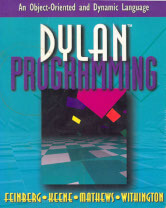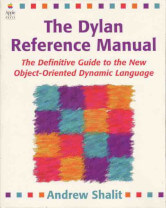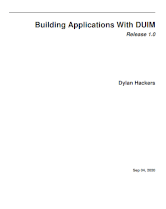Last Updated on May 19, 2024
Dylan is a multi-paradigm programming language that includes support for functional and object-oriented programming (OOP). This language is dynamic and reflective while providing a programming model designed to support generating efficient machine code, including fine-grained control over dynamic and static behaviors.
Dylan uses an algebraic infix syntax similar to Pascal or C, but supports an object model not unlike the Common Lisp Object System (CLOS).
It was created in the early 1990s by a group led by Apple Computer.
Here’s our recommended books to learn this language.
1. Dylan Programming by by Neal Feinberg, Sonya E. Keene, Robert O. Mathews, P. Tucker Withington
 The primary goals of this book are to teach you how to program in Dylan, and how to write programs in an object-oriented style.
The primary goals of this book are to teach you how to program in Dylan, and how to write programs in an object-oriented style.
Along the way, the authors hope to convince you to use Dylan. It is intended to be a practical, elegant, and fun language to use.
This book is written for application programmers who have experience working in a conventional language, such as C, Pascal, COBOL, FORTRAN, or BASIC, or in an object-oriented language, such as C++, Java, Smalltalk, or Common LISP with CLOS. Familiarity with object-oriented programming and dynamic languages is not required. The authors do compare Dylan to C, C++, and Java in this book, but you can read and understand the book without any knowledge of these languages.
This book is a tutorial on programming in Dylan, and it offers the following:
- Begins with the most basic use of Dylan, and gradually expands to show the more powerful and advanced techniques.
- Gives the flavor of working with the Dylan language in a typical Dylan environment.
- Shows you how to define classes and methods that work together to solve a problem.
- Shows you how to use many of Dylan’s classes, functions, and features to good effect within the context of an example application.
- Introduces the more advanced features of Dylan, including multiple inheritance, performance, exceptions, and macros
2. The Dylan Reference Manual by Andrew Shalit
 The Dylan Reference Manual is the complete specification and reference of the Dylan programming language.
The Dylan Reference Manual is the complete specification and reference of the Dylan programming language.
The book is divided into three parts: chapters 1 through 10 describe the overall structure and semantics of the language; chapters 11 through 14 provide a reference describing every class, function, and syntactic construct in the language; appendices contain the BNF for Dylan’s syntax, a listing of names used by the Dylan language, and a glossary of terms.
The book will be of interest to users of Dylan, as well as to those who have a general interest in object-oriented programming and modern programming languages. It is not, however, a tutorial.
3. Building Applications With DUIM by Dylan Hackers
 Building Applications using DUIM, provides an introduction to developing your own windowed applications using Open Dylan and, in particular, the interface-building functionality provided by the DUIM library suite.
Building Applications using DUIM, provides an introduction to developing your own windowed applications using Open Dylan and, in particular, the interface-building functionality provided by the DUIM library suite.
It is designed to complement Getting Started with Open Dylan, which provides information on using the Open Dylan development environment, and the DUIM Reference Manual, which provides a complete reference to the DUIM library suite. You are advised to look at Getting Started with Open Dylan before reading this manual in any depth.
All books in this series:
| Free Programming Books | |
|---|---|
| Ada | ALGOL-like programming language, extended from Pascal and other languages |
| Agda | Dependently typed functional language based on intuitionistic Type Theory |
| Arduino | Inexpensive, flexible, open source microcontroller platform |
| Assembly | As close to writing machine code without writing in pure hexadecimal |
| Awk | Versatile language designed for pattern scanning and processing language |
| Bash | Shell and command language; popular both as a shell and a scripting language |
| BASIC | Beginner’s All-purpose Symbolic Instruction Code |
| C | General-purpose, procedural, portable, high-level language |
| C++ | General-purpose, portable, free-form, multi-paradigm language |
| C# | Combines the power and flexibility of C++ with the simplicity of Visual Basic |
| Clojure | Dialect of the Lisp programming language |
| ClojureScript | Compiler for Clojure that targets JavaScript |
| COBOL | Common Business-Oriented Language |
| CoffeeScript | Transcompiles into JavaScript inspired by Ruby, Python and Haskell |
| Coq | Dependently typed language similar to Agda, Idris, F* and others |
| Crystal | General-purpose, concurrent, multi-paradigm, object-oriented language |
| CSS | CSS (Cascading Style Sheets) specifies a web page’s appearance |
| D | General-purpose systems programming language with a C-like syntax |
| Dart | Client-optimized language for fast apps on multiple platforms |
| Dylan | Multi-paradigm language supporting functional and object-oriented coding |
| ECMAScript | Best known as the language embedded in web browsers |
| Eiffel | Object-oriented language designed by Bertrand Meyer |
| Elixir | Relatively new functional language running on the Erlang virtual machine |
| Erlang | General-purpose, concurrent, declarative, functional language |
| F# | Uses functional, imperative, and object-oriented programming methods |
| Factor | Dynamic stack-based programming language |
| Forth | Imperative stack-based programming language |
| Fortran | The first high-level language, using the first compiler |
| Go | Compiled, statically typed programming language |
| Groovy | Powerful, optionally typed and dynamic language |
| Haskell | Standardized, general-purpose, polymorphically, statically typed language |
| HTML | HyperText Markup Language |
| Icon | Wide variety of features for processing and presenting symbolic data |
| J | Array programming language based primarily on APL |
| Java | General-purpose, concurrent, class-based, object-oriented, high-level language |
| JavaScript | Interpreted, prototype-based, scripting language |
| Julia | High-level, high-performance language for technical computing |
| Kotlin | More modern version of Java |
| LabVIEW | Designed to enable domain experts to build power systems quickly |
| LaTeX | Professional document preparation system and document markup language |
| Lisp | Unique features - excellent to study programming constructs |
| Logo | Dialect of Lisp that features interactivity, modularity, extensibility |
| Lua | Designed as an embeddable scripting language |
| Markdown | Plain text formatting syntax designed to be easy-to-read and easy-to-write |
| Objective-C | Object-oriented language that adds Smalltalk-style messaging to C |
| OCaml | The main implementation of the Caml language |
| Pascal | Imperative and procedural language designed in the late 1960s |
| Perl | High-level, general-purpose, interpreted, scripting, dynamic language |
| PHP | PHP has been at the helm of the web for many years |
| PostScript | Interpreted, stack-based and Turing complete language |
| Prolog | A general purpose, declarative, logic programming language |
| PureScript | Small strongly, statically typed language compiling to JavaScript |
| Python | General-purpose, structured, powerful language |
| QML | Hierarchical declarative language for user interface layout - JSON-like syntax |
| R | De facto standard among statisticians and data analysts |
| Racket | General-purpose, object-oriented, multi-paradigm, functional language |
| Raku | Member of the Perl family of programming languages |
| Ruby | General purpose, scripting, structured, flexible, fully object-oriented language |
| Rust | Ideal for systems, embedded, and other performance critical code |
| Scala | Modern, object-functional, multi-paradigm, Java-based language |
| Scheme | A general-purpose, functional language descended from Lisp and Algol |
| Scratch | Visual programming language designed for 8-16 year-old children |
| SQL | Access and manipulate data held in a relational database management system |
| Standard ML | General-purpose functional language characterized as "Lisp with types" |
| Swift | Powerful and intuitive general-purpose programming language |
| Tcl | Dynamic language based on concepts of Lisp, C, and Unix shells |
| TeX | Markup and programming language - create professional quality typeset text |
| TypeScript | Strict syntactical superset of JavaScript adding optional static typing |
| Vala | Object-oriented language, syntactically similar to C# |
| VHDL | Hardware description language used in electronic design automation |
| VimL | Powerful scripting language of the Vim editor |
| XML | Rules for defining semantic tags describing structure ad meaning |

I like Dylan because it’s both object-oriented, like C++ and Java, and dynamic, like Smalltalk.